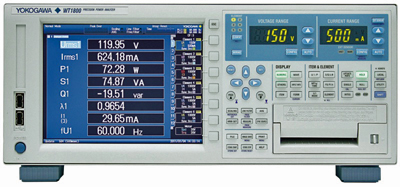
|
|
The Yokogawa WT1800 series High Performance Power Analyzer is available in six versions, up to six input elements. It has innovative functions help improve measurement efficiency; Motor, Inverter, Lighting, EV/HEV, Battery, Power Supply, Aircraft, New Energy, Power Conditioner. Direct input of measurement signals makes it possible to measure very small current that can hardly be measured with a current sensor. The WT1800 provides a direct input voltage range from 1.5 V to 1000 V (12 ranges) and a direct input current range from 10 mA to 5 A (9 ranges) or from 1 A to 50 A (6 ranges). The frequency lower limit has been reduced to 0.1 Hz from the previous 0.5 Hz (5-fold lower than the previous model) to meet the requirement for power measurements at a low speed. Furthermore, high-speed data collection at a data update rate of up to 50 ms has been inherited. In addition to normal measurement data, up to the 500th order harmonic data can be measured and saved simultaneously. The data update rate can be selected from nine options from 50 ms to 20 s. Specifications. Basic power accuracy (50/60Hz): 0.1% of reading + 0.05% of range. Power frequency range: DC, 0.1 Hz ~ 1 MHz. Input elements: 1, 2, 3, 4, 5, 6. Voltage range: 1.5/ 3/ 6/ 10/ 15/ 30/ 60/ 100/ 150/ 300/ 600/ 1000 [V]. Current range (direct input): 10m/ 20m/ 50m/ 100m/ 200m/ 500m/ 1/ 2/ 5 [A] or 1/ 2/ 5/ 10/ 20/ 50 [A]. Current range (external sensor input): 50m/ 100m/ 250m/ 500/ 1/ 2.5/ 5/ 10 [V]. Guaranteed accuracy range for voltage and current: 1% to 110%. Basic voltage/current accuracy: +/-0.1%. Basic power accuracy: +/-0.05%. Frequency range: DC, 0.1Hz to 1 MHz. Voltage/Current frequency range (-3 dB, typical): 5 MHz. Sampling speed: approximately 2 MS/s. Data update rate: 50 m, 100 m, 200 m, 500 m, 1, 2, 5, 10, 20 [sec]. Line filter: OFF, digital filter 100 Hz to 100 kHz (100 Hz step) analog filter 300 kHz, 1 MHz. Frequency filter: OFF, 100 Hz or 1 kHz. Fundamental frequency of the PLL source: 0.5 Hz to 2600 Hz (internal sampling clock), without external sampling clock function. Display: 8.4-inch color TFT LCD display, Total number of pixels* 1024 (horizontal) × 768 (vertical) dots. Options. /EX1-6 (version dependent), External current sensor input. /B5, Built-in printer. /G5, Harmonic Measurement. /G6, Simltaneous Dual Harmonic Measurement. /DT, Delta Computation. /FQ, Add-on Frequency Measurement. /V1, RGB output. /DA, 20-channel DA Outputs. /MTR, Motor Evaluation Function. /AUX, Auxiliary Sensor Inputs. /HS, High speed data capturing.
|